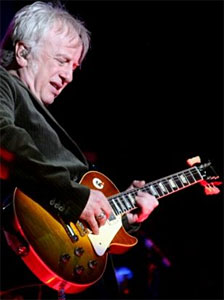How to Make a Les Paul Aerosmith-Worthy
 If a pedigree counts for something, and it always does, it’s tough to beat the three simians that founded 3 Monkeys Amps. The equation goes something like this:
If a pedigree counts for something, and it always does, it’s tough to beat the three simians that founded 3 Monkeys Amps. The equation goes something like this:
Greg Howard: guitar tech to the stars including Brad Whitford, the Black Crowes, etc.
+
Ossie Ahsen: tech and owner of the former (and highly regarded) Blockhead amps
+
Brad Whitford: needs no explanation but will add that he has ears for wood big-time
=
Woody friggin’ Tone!
Pedigree for sure, but right now we’re going to get away from amps for a bit. Why? Well, if you go on the 3 Monkeys website, the story of how the company began starts like this:
In 2002 Greg started working with Brad as his touring guitar tech. They immediately bonded over gear and tone, over the next 5 months Greg helped Brad to acquire a dozen new guitars, a bunch of new effects pedals, amps, etc. Brad even had his original ’59 Gibson Les Paul on tour until Greg replaced the electronics in Brad’s Gibson Historic ’59 Les Paul with some handwound pickups, correct CTS pots and caps, and an aluminum tailpiece. The ‘real’ ’59 was returned home and the Historic immediately became his number one guitar.
Whoa! Stomp on the brakes right there. Small fortunes have been spent and made in the quest to make a new Les Paul sound like an old one. That’s interesting.
Actually, in this case it’s super interesting because we have Greg, a guy who knows how to do it (isn’t merely trying to do it), and Brad, who could pick from probably a half-dozen amazing-sounding Les Pauls just in his closet and yet played the “doctored” one.
Hmmm. What to do? Call Greg!
Tried to get him to spill some beans, didn’t expect him to spill ’em all, but here’s what we got.
WoodyTone: How did you know you could get that repro Les Paul to sound nearly as good as the original?
Greg: I knew I could get it close by just changing the pickups and a few parts.
The changes you made – were they generic ones you knew would work or were they specific to the guitar?
Pretty much any Les Paul, but it doesn’t always work. I basically examined his real one and determined that just a few parts changes would at least get it in the ballpark, and it did. With some of the parts it’s trial and error.
Can you tell us what the main things were tone-wise?
The main tone differences were the tailpiece and the pickups, and the caps and pots. I changed the stock TP to an aluminum one because that’s what the original had. That’s a subtle difference – I don’t think it’s something where you immediately go, “Oh that’s it.” But it definitely evens out the tone – the bass and treble strings are a little less different.
I changed the stock pickups to Timbuckers, hand wound by Tim White [he no longer makes pickups]. At the time, in 2002, they were the best handwound PAFs I’d found. I still like them – I have a set in my personal ’58 Plaintop Historic – but I think that guitar [Brad’s ’59 Tom Murphy aged Les Paul] has stock [Gibson] Burstbuckers in it now.
I also changed the capacitors on the tone pots to NOS Bumblebees and changed all the pots to like-value CTS. This was really the key in getting the guitar to sound more like the real ’59.
The caps are that big a deal?
Capacitors affect everything – it’s what determines the the capacitance of the tone control, which interacts with the volume control even when the tone control is full up.
What one change would you make first to any Les Paul to get it to sound more ‘woody?’
The tailpiece or the nut. Some Les Pauls, especially used ones, have a bad nut on them – cheap plastic, graphite, brass. I think those are sterile-sounding. I prefer high-grade plastic or bone. [He didn’t have a particular brand to recommend.]
_____
Here’s Brad and friends (Audley Freed!) playing “Last Child.” Don’t think that’s the guitar in question (Greg?), but very cool to see Brad play all the leads – great stuff and sounds woody!
Category: 3Monkeys Amps, Aerosmith, Brad Whitford, Les Paul, Tim White pickups













